Survey No. 12: Abstraction
In our art history survey, we are now at the end with the 1900s. The big “revelation” in Western art starting very late in the 1800s and flowering in the early 1900s was abstraction. Abstraction is defined basically as any art that does not represent observed elements of the physical world. Where objects of the physical world are the subject matter, they are abstract if reduced to simple, stylized forms.
The basic change in Western art was from the physical to the cerebral. Isn’t it interesting how these criteria are found in art long before abstraction was “invented” by Western artists?
The following are works from cultures that are known to have influenced groundbreaking Western artists and led them to explore abstraction.
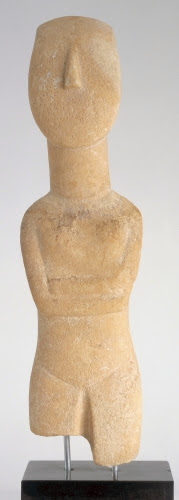 |
| Ancient Aegean, Cycladic Culture, Figure of a Woman, ca. 3000–2000 BCE. Marble, 13 3/8" x 3 5/8" x 1 3/4" (34 x 9.2 x 4.4 cm). © Albright-Knox Art Gallery, Buffalo, NY. (AK-44) |
Correlations to Davis programs: Explorations in Art Grade 6: 1.4; A Community Connection: 3.2; A Global Pursuit: 1.4; Beginning Sculpture: 5; Exploring Visual Design: 10; Discovering Art History: 6.1; The Visual Experience: 10.2 |
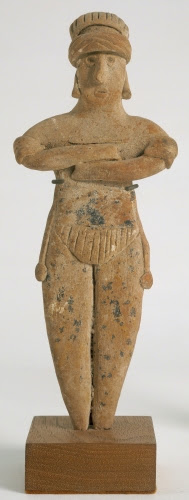 |
| Ancient Mexico, Colima Culture, Standing Female, ca. 300 BCE–500 CE. Terra cotta, 7 1/4" x 2 3/4" x 1 1/8" (18.4 x 7 x 2.9 cm). © Albright-Knox Art Gallery, Buffalo, NY. (AK-901) |
Correlations to Davis programs: Explorations in Art Grade 6: 1.4; A Community Connection: 1.5, 3.2; Beginning Sculpture: 5; Discovering Art History: 4.9; The Visual Experience: 10.2 |
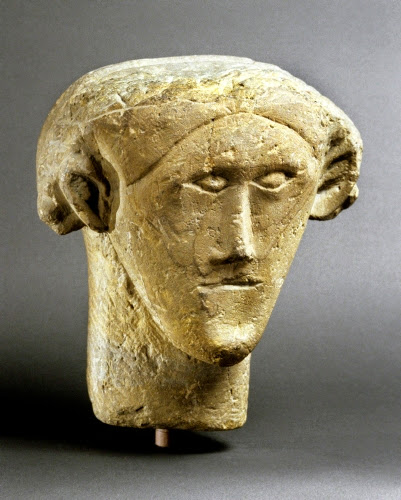 |
| Britain, Celtic culture, Male Head, ca. 100s–200s CE. Sandstone with traces of red pigment, 13" x 11 3/4" (33 x 29.9 cm). © Cleveland Museum of Art. (CL-588) |
Correlations to Davis programs: Explorations in Art Grade 6: 1.4; A Community Connection: 3.2; Beginning Sculpture: 5; Discovering Art History: 7.1; The Visual Experience: 10.2 |
 |
| Maruyama Ōzui (1766–1829, Japan), Carp and Waterfall, 1796. Ink and color on silk, hanging scroll, 52 1/2" x 16 9/16” (133.5 x 42.1 cm). © Museum of Fine Arts, Boston. (MFAB-951) |
Correlations to Davis programs: Explorations in Art 1 4.connections; Explorations in Art 2 3.14; Explorations in Art 3 5.27-28 studio; Explorations in Art 4 4.conn., 4.21-22 studio; A Community Connection 6.2; A Global Pursuit 7.5; Experience Painting 4; Exploring Painting 5; Exploring Visual Design 1, 7, 12; The Visual Experience 9.3, 13.5; Discovering Art History 4.4 |
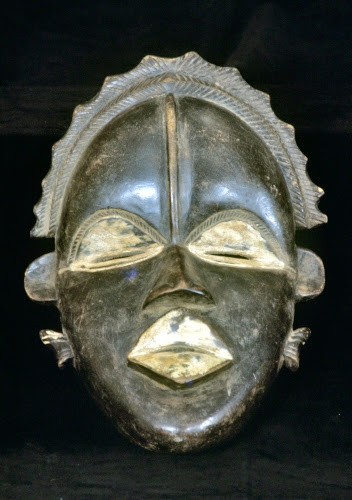 |
| Dan People, Liberia, Mask, late 1800s–early 1900s. Wood, 11 3/8" x 9" (29 x 23 cm). Private Collection, photo © Davis Art Images. (8S-10551) |
Correlations to Davis programs: Explorations in Art Grade 1: 5.29-30 studio; Explorations in Art Grade 4: 5.30, 5-29-30 studio; Explorations in Art Grade 6: 3.17-18 studio; A Personal Journey: 7.6; A Community Connection: 3.2, 7.6; A Global Pursuit: 1.5; Beginning Sculpture: 5; The Visual Experience: 10.2, 10.15, 14.3, 14.7; Discovering Art History: 4.8 |
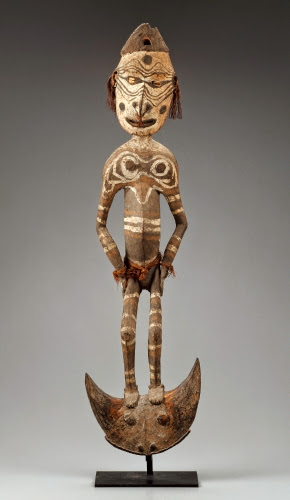 |
| Iatmul People, Papua New Guinea, Suspension Hook, late 1800s to early 1900s. Wood, fiber, shell, and pigment, 36" x 11" x 6" (91.4 x 27.9 x 15.2 cm). © Museum of Fine Arts, Boston. (MFAB-738) |
Correlations to Davis programs: Explorations in Art Grade 6: 1,4; A Community Connection: 3.2; A Global Pursuit: 6.5; Beginning Sculpture: 5; The Visual Experience :10.2; Discovering Art History: 4.6 |
The following are artworks that I feel meet the criteria of “abstraction.” As you can see, they come from all places and all periods. Some of these cultures may have, over the last hundred-something years, had an impact on the abstraction of some Western artist, or contemporary artists in these cultures.
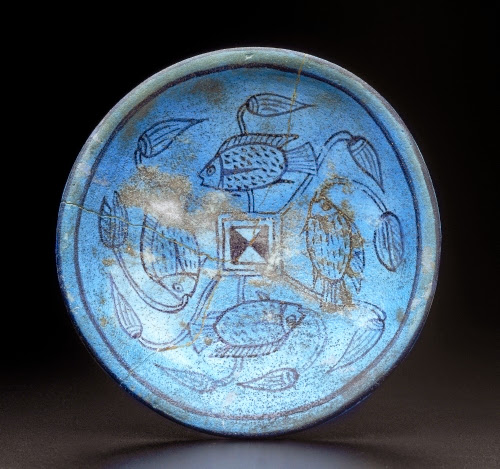 |
| Ancient Egypt, “Marsh” Bowl, ca. 1400 BCE. Faience ware, width: 6 3/16" (15.7 cm). © Museum of Fine Arts, Boston. (MFAB-722) |
Correlations to Davis programs: Explorations in Art Grade 2: 3.17-18 studio; Explorations in Art Grade 3: 6.35; A Personal Journey: 3.4; A Community Connection: 2.6, 5.2; A Global Pursuit: 1.4; Experience Clay: 4; The Visual Experience: 10.6, 15.3; Discovering Art History: 5.3 |
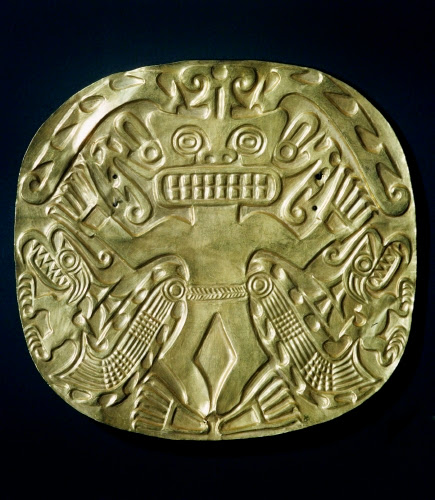 |
| Ancient Panama, Chest plaque, from Sitio Conte, 400–900 CE. Hammered gold, 9 7/8" x 10 1/2" (25.1 x 26.7 cm) © Cleveland Museum of Art (CM-432) |
Correlations to Davis programs: Explorations in Art Grade 2: 2.11; Explorations in Art Grade 3: 2.7-8 studio; Explorations in Art Grade 6: 1.4, 5.29; A Personal Journey: 7.conn.; A Community Connection: 1.5, 5.2; Exploring Visual Design: 1; The Visual Experience: 10.7, 14.4; Discovering Art History: 2.2, 4.9 |
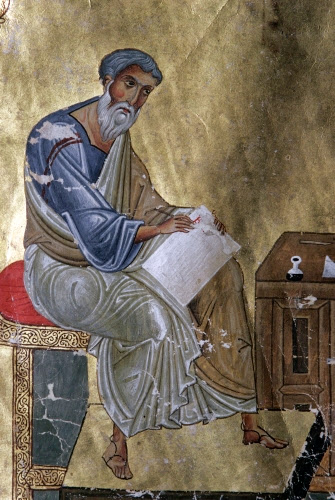 |
| Byzantine, Saint Matthew Writing his Gospel, page excised from a lectionary, from Constantinople (current Istanbul), Turkey, 1057–1063. Tempera and gold leaf on vellum, 11 5/16" x 9 1/2" (28.8 x 24.3 cm). © Cleveland Museum of Art. (CM-429) |
Correlations to Davis programs: Explorations in Art Grade 3: 1.3, 3.17-18 studio; Explorations in Art Grade 4: 1.2; Explorations in Art Grade 6: 1.1, 1.4, 3.16; A Community Connection: 6.2; A Global Pursuit: 3.4; Experience Painting: 1; Communicating Through Graphic Design: 5; The Visual Experience: 9.3, 15.6; Discovering Art History: 7.2, 7.activity 2 |
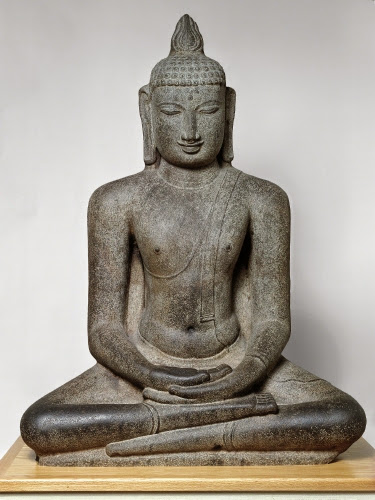 |
| India, Buddha Seated in Meditation, from Tamil Nadu, ca. 1100s. Granite, 63" x 47 5/16" x 22 1/8" (160 x 120.2 x 56.3 cm). © Art Institute of Chicago. (AIC-386) |
Correlations to Davis programs: Explorations in Art Grade 5: 1.3-4 studio; A Community Connection: 3.2; A Global Pursuit: 3.5; Beginning Sculpture: 5; The Visual Experience: 10.3, 10.13, 13.2; Discovering Art History: 4.2 |
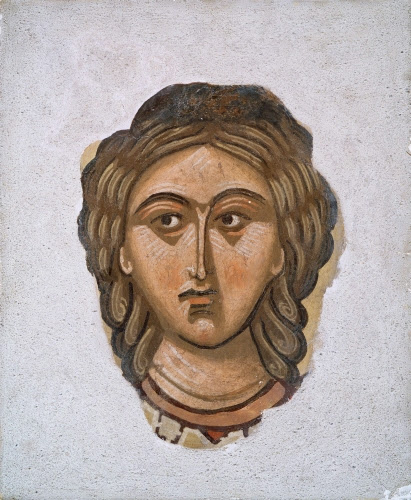 |
| Byzantine, Head of a Saint, 1100s–1300s. Fresco fragment transferred to panel, commissioned for the Church of Hagiou Staurou, Jerusalem, 14 3/4" x 10 9/16" (37.4 x 27 cm). © Museum of Fine Arts, Boston. (MFAB-1220) |
Correlations to Davis programs: Explorations in Art Grade 3: 1.1-2 studio, 1.3; Explorations in Art Grade 6: 1.1, 1.3, 1.4; A Community Connection: 6.2; A Global Pursuit: 2.4; Experience Painting: 8; Exploring Painting: 4, 10; Exploring Visual Design: 10; The Visual Experience: 9.3, 15.6; Discovering Art History: 7.2 |
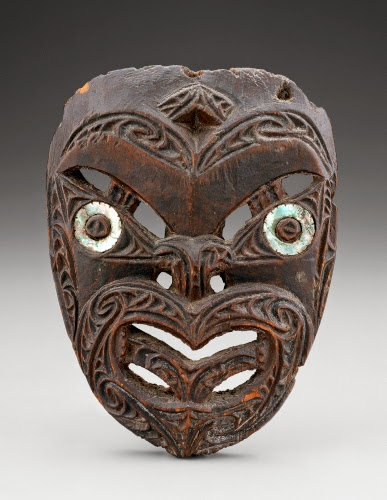 |
| Maori People, New Zealand, Maskette, 1800s–1900s. Wood, haliotis shell, height: 6" (15.2 cm). © Museum of Fine Arts, Boston. (MFAB-747) |
Correlations to Davis programs: Explorations in Art Grade 1: 5.29-30 studio; Explorations in Art Grade 4: 5.30; Explorations in Art Grade 6: 1.4, 3.17-18 studio; A Personal Journey: 7.6; A Community Connection: 3.2, 7.6; A Global Pursuit: 6.5; Beginning Sculpture: 5; The Visual Experience: 10.2, 10.15, 14.7; Discovering Art History: 4.6 |


Comments